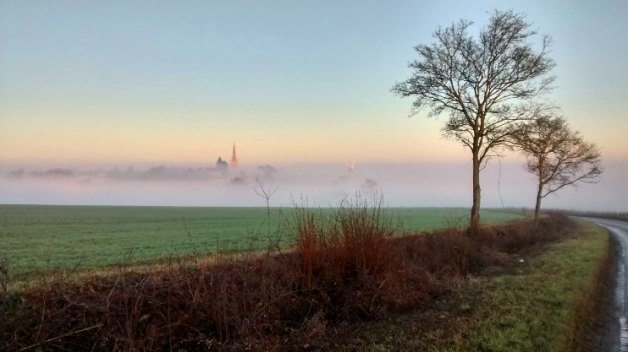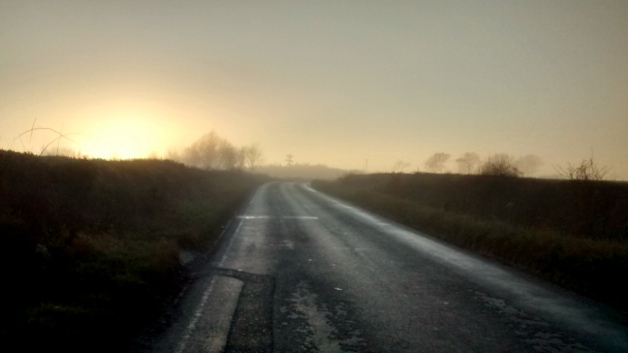Author

 Off I rode. Jersey pockets crammed with food, legs spinning lightly through mile upon mile upon mile. Flow. The state of mind where nothing exists. The landscape a blur, your only focus the motion, the turning of pedals. Bliss.
Off I rode. Jersey pockets crammed with food, legs spinning lightly through mile upon mile upon mile. Flow. The state of mind where nothing exists. The landscape a blur, your only focus the motion, the turning of pedals. Bliss.
 Zone 2, asked a fellow club member who only ever rides proper, no cycling training gobbledygook part of his diction. Conversation pace, the pace you set when just riding, neither fast nor particularly slow, a tempo you can hold all day, all night.
Zone 2, asked a fellow club member who only ever rides proper, no cycling training gobbledygook part of his diction. Conversation pace, the pace you set when just riding, neither fast nor particularly slow, a tempo you can hold all day, all night.
 A common refrain from many coaches nowadays. The argument is a good one, logical at least. Unless you’ve got many, many hours to spend then the time required to ride at base pace is beyond most time crunched cyclists.
A common refrain from many coaches nowadays. The argument is a good one, logical at least. Unless you’ve got many, many hours to spend then the time required to ride at base pace is beyond most time crunched cyclists.


For further information log on website :
https://humancyclist.wordpress.com/2017/01/29/base-mile-training/

I don’t know how it began, nor why. Before I knew it I was clocking up monster winter rides every weekend, 100 miles minimum. December through January. In the UK. Nuts?
Average ride temperatures between -1 and 3 degrees Celsius, 8 hours of daylight if you’re lucky, or if you actually bothered to set your alarm, which I didn’t. Setting off late morning into the gloom, the day already darkening. Part of some grand training plan? Kind of, but not really. I was simply enjoying myself. Why?
Mid December 2016, my last century ride 2.5 years previous when I’d convinced myself I didn’t enjoy long rides. Yet things are different this time around. I’m sticking to base pace, strictly zone 2.
A break from cycling, specifically intervals and a year of structured training, riding base miles felt like a great release, an escape from the shackles of numbers and graphs and spreadsheets.
Just riding. Proper bike rides. Proper? You know the sort. Open the door, head off, no plan in mind, no nothing but the entire day on the bike. Yet I did have a plan. Ride 100 miles, zone 2, steady, no sprinting, no tempo, not even on hills.
The twilight world of winter base miles
 Off I rode. Jersey pockets crammed with food, legs spinning lightly through mile upon mile upon mile. Flow. The state of mind where nothing exists. The landscape a blur, your only focus the motion, the turning of pedals. Bliss.
Off I rode. Jersey pockets crammed with food, legs spinning lightly through mile upon mile upon mile. Flow. The state of mind where nothing exists. The landscape a blur, your only focus the motion, the turning of pedals. Bliss.
The sun low all day. Hours pass. Many hours. Six, seven, geez, eight hours. Loooooong days. Light fading, temperatures dipping, the setting sun igniting the sky for you, one last hoorah before it passes the illumination baton to the moon.
The road disappears. Lights on, the world reduced to a narrow tunnel of light. Mist as thick as your saliva at mile 90. Thirsty. Eyes alert for ice, for potholes, for the next turn. Your only sense of motion is from seeing the road rush beneath your wheels, riding at night you always feel faster, speeding through a black hole, you, the last person on earth.
Home, depleted and at a loss in the harsh bright lights of a motionless world. 100 miles, you think, somewhat perplexed by your own actions. Limbs you last felt many hours ago tingle with signs of recovery, of pain. Body and mind in shock, in awe. You’re lost to the world for the next two days, limbs loose yet lifeless, food and sleep on your mind.
Yet this was no one off. Next weekend the same, and the one after and the one after. Two months of century rides each weekend. Every ride easier than the last, your body adjusting to your flights of fancy. The pace quickens, the elevation rises and the miles increase from madness to absurdity.
What is base training?
 Zone 2, asked a fellow club member who only ever rides proper, no cycling training gobbledygook part of his diction. Conversation pace, the pace you set when just riding, neither fast nor particularly slow, a tempo you can hold all day, all night.
Zone 2, asked a fellow club member who only ever rides proper, no cycling training gobbledygook part of his diction. Conversation pace, the pace you set when just riding, neither fast nor particularly slow, a tempo you can hold all day, all night.
You are a metronome, a robot stuck in one gear, not quite coasting yet nowhere near heavy breathing. On hills you spin easy gears lightly, maintaining your heart rate if not your pace. This is all about endurance, riding at about 60-70% of your max heart rate or 55-75% of your FTP power. This is a time to build a base way before you get to the ‘my eyeballs are popping out of my head’ intervals. Enjoy it.
Base mile benefits
- Burn fat not your limited glycogen stores, which means you’ll have more in the tank when you need to call on your sugar reserves
- Boost your mitochondria, which means more efficient processing of lactic acid
- Practice your cadence, spinning lightly – you’ll be surprised how difficult this feels towards the end of a long slow ride
- Get your body used to the bike – practice getting down low and aero whilst maintaining power
- Social – find a group, have a natter, enjoy the cafe stop*
- Beauty – riding in deep dark winter is one of the few chances to see both the sunrise and sunset in the same ride
- Improve your efficiency – slowly but surely build your speed at lower heart rates
- Build your endurance, ride all day
*Group riding and base miles is a tricky one. Everyone’s ‘base’ may not be equal and there’s always the temptation as a group to hammer it, or at least ride harder than you should.
Base miles are a waste of time
 A common refrain from many coaches nowadays. The argument is a good one, logical at least. Unless you’ve got many, many hours to spend then the time required to ride at base pace is beyond most time crunched cyclists.
A common refrain from many coaches nowadays. The argument is a good one, logical at least. Unless you’ve got many, many hours to spend then the time required to ride at base pace is beyond most time crunched cyclists.
We’re better training at what’s being called sweetspot base. Riding just above tempo pace and just below your threshold. Short and not too sharp.
I worked on such a plan last year to much success, my FTP increasing 8% each month until, wham, burnout. My fitness peaked quickly but it faded just as fast and I often felt tired. This year my FTP increases are at 4% and so far I feel fresh despite the increased workload from the long rides. Will this year be more sustainable? I’ll let you know come July! [See update below, one year on]
Has the myth of base miles been greatly exaggerated and misinterpreted? The coaches calling base miles useless are the very same coaches making a living from prescribing structured training programmes. Nobody needs a coach for base miles.
Even the article linked above, “The myth of base training”, whilst having many good points, also says it loud and clear, base miles do have a benefit if you are using them to increase your weekly training load.
“When base training works, it only works because increased training volume contributes to greater total workload (or at least greater focused workload) despite reduced intensity”
Base miles work when you raise your volume and also, over time, your intensity over the same big distances. Slowly but surely you can raise base pace from low zone 2 to high zone 2, before throwing in a few tempo segments. Base miles alone will reduce your intensity, so are best used as part of a variety of rides where you are completing the odd tempo ride here and there. What about eye ball out intervals? Joe Friel, the Yoda of cycle training plans, believes they’re best saved for later in the year when you actually need to maintain this pace. Riding at high intensity so early in the year increases the risk of a premature burnout.

Wow, look at that, I started talking about the beauty of long miles and still ended up talking about structured training! This wasn’t why I began riding base miles. Well it was, kind of, but not really. I’d read an article from one of the Godfather’s of cycle training, where Hunter Allen talked of long rides being the key to reaching the next level in your training. My brain took this piece of advice and did what humans do best, adapted it to fit in with my current situation, rendering the original advice useless.
It matters not, I have enjoyed riding these big, beautiful winter miles and it’s nice to remember that cycling is to be enjoyed, not endured.
Post-season update: So, what was the result of my many base miles? As predicted above, I didn’t burnout so early this year (burnout came once again once I switched to the high intensity intervals).
What else? My endurance levels were incredible. Come summer I was riding high and far at a strong pace over multiple days without crumbling.
What about my speed? Did base miles make me quicker? Alone, who knows. Mixed in as part of a broader training plan, then yes. I went from hanging on during clubs rides, to leading club rides, even with the fast boys and girls. It was an amazing feeling.
So will I be repeating base miles this year? Undoubtedly, in fact I’ve just finished my first long ride! What’s more I’ll be breaking the year down into two periods, and will ensure I have solid base miles not once but twice. This is to give my body a break to avoid early burnout.
What will I change? I’ll be raising my pace a little, aiming for the upper limits of base pace rather than in the middle. There’s a few articles which suggest this is where the gains are to be made.
What won’t change is balancing long base miles with short sweetspot rides. You need to keep some intensity in your rides to avoid losing your top end.

For further information log on website :
https://humancyclist.wordpress.com/2017/01/29/base-mile-training/





No comments:
Post a Comment